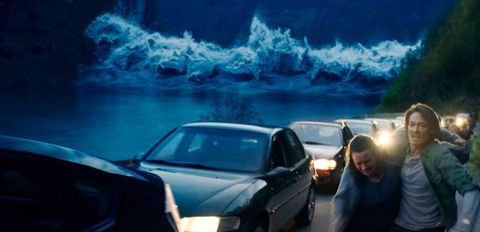Set in the tiny Norwegian village of Geiranger, The Wave is led by Kristoffer Joner’s Kristian, a geologist who is working on his last day analyzing the sturdiness of the mountain that sits above the fjord. The Wave’s opening montage reminds us that over the last 100 or so years, there have been three incidents in Norway where rockslides have instigated a tsunami that have then led to deaths of dozens of people. And Kristian has just seen signs that it’s going to happen again.
Kristian faces resistance from his superior though, who think that he’s over-reacting to the data that’s coming his way. Meanwhile Kristian’s wife, Idun (Ane Dahl Torp), is more concerned that he’s supposed to be driving their children to their new home, rather than returning to his former work to insist that a rockslide is imminent.
Kristian’s concerns fall on deaf ears, of course. And after he and his children miss the last boat out of Geiranger, the rockslide occurs -- triggering a 300-foot tsunami to head straight to the village, and the inhabitants only have 10 minutes to find shelter or reach the mountains for safety. Raise your hand if you are surprised.
The Wave wears its Hollywood inspiration openly and proudly. Not only is there a big red button that is just asking to be pushed, but The Wave’s lead protagonist even stares up at a creaky mountain days before it breaks free, lands in a fjord, and causes a tsunami, much in the same way that a wrestler sizes up his or her opponent.
Because of this, at times, The Wave is kind of stupid. But the magnificently named director Roar Uthaug and writers John Kare Raake and Harald Rosenlow-Eeg also know that these sequences, which American cinema has been replicating for decades, are a shorthand between the film and its audience. And they do the necessary job of increasing dread, raising the stakes and creating a connection between us and the nervous lead.
But while it embraces the formula and cliché of the disaster genre, The Wave is also proudly Norwegian and European, and this mixture of a quaint locale with Hollywood panache makes it refreshingly original. Unfortunately, The Wave gets caught and flounders in between these two worlds. Without the budget to compliment its one impressive disaster sequence, The Wave repeatedly threatens to descend into hackneyed mediocrity that wouldn’t look out of place as a TV movie. It avoids this embarrassment by focusing on the human aspects of such a devastation, which is a welcome relief from the stock characters, wails of dialogue, and usual conflicts that The Wave uses and steals from the hoards of other disaster films.
The Wave is ultimately too ambitious for its own good. While it commendably tries to play Hollywood at its own game, it takes too long for the tsunami to hit and catalyse the film. Before that point it goes through a check-list of disaster cliché. There’s the conflicted family, bratty teenager, know-it-all boss, moments of infuriating stupidity, and hero that’s just left his job and wants to save his family.
All of this is just a bit more bearable because of the quaint, appealing European locale and eccentric characters. While, despite the waiting time, once the tsunami is triggered excitement instantly grows. After the disaster has struck, The Wave takes an original twist on the genre by focusing on the brutal human struggles and problems that would arise in such a situation. Sure, we also have to see Kristian trekking back down in Geiranger in order to find his family, but along the way he encounters a series of dank and unpleasant findings that give The Wave an edge that the genre often lacks.
Which makes it even more of a shame that its finale feels rushed and goes out of its way to unnecessarily add extra drama. Because of its lack of budget and scope, The Wave is more of a cutesy homage rather than a formidable rival to its Hollywood peers.
Most Popular






